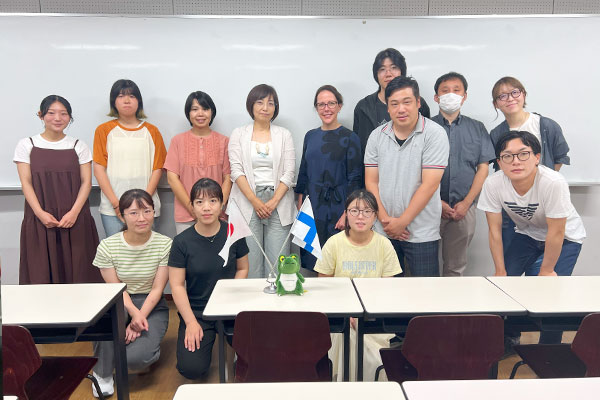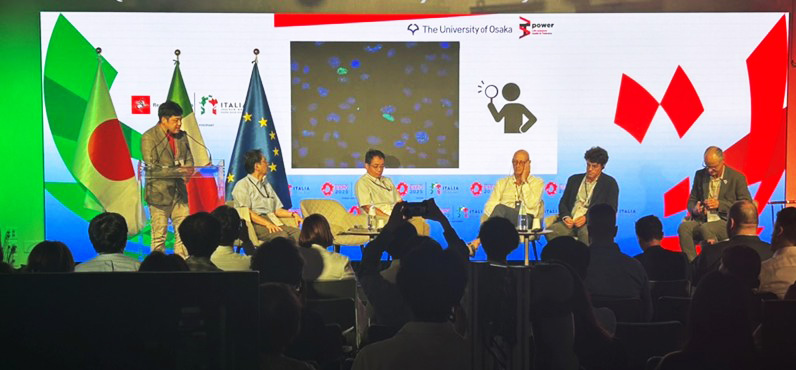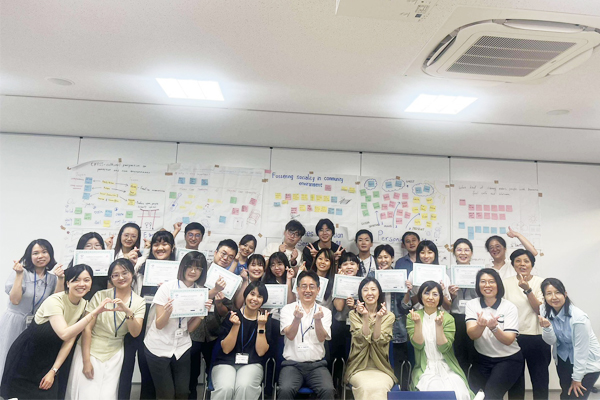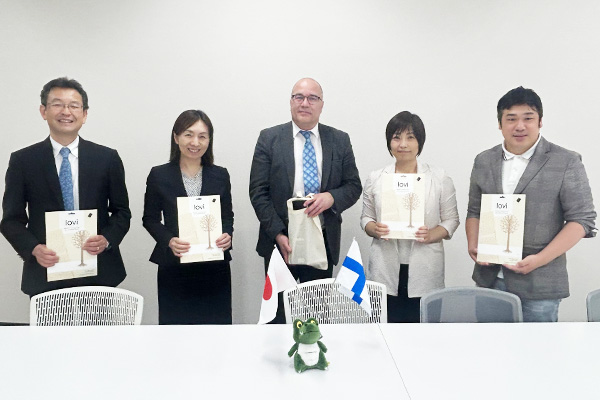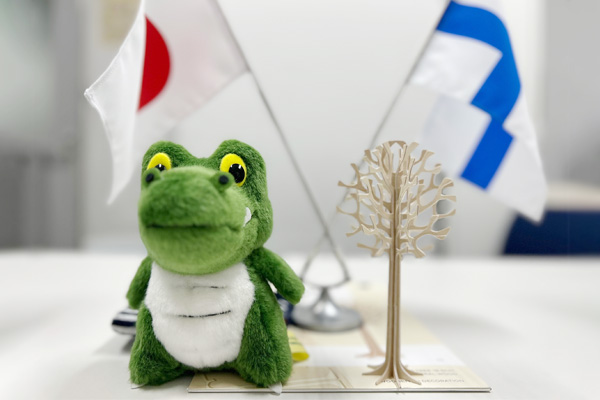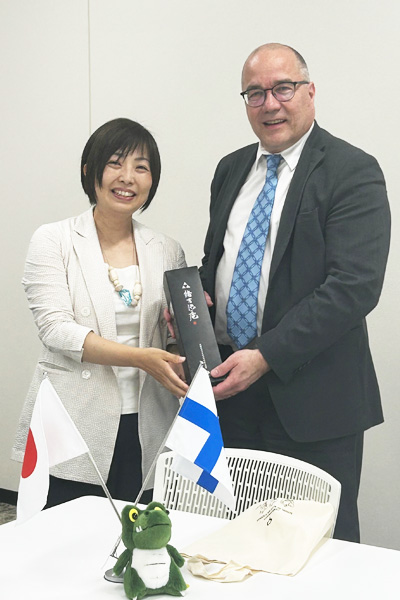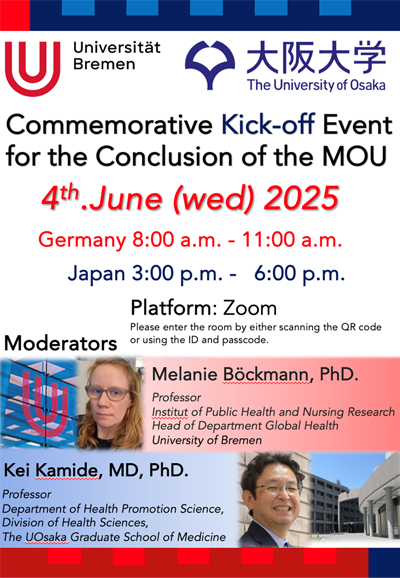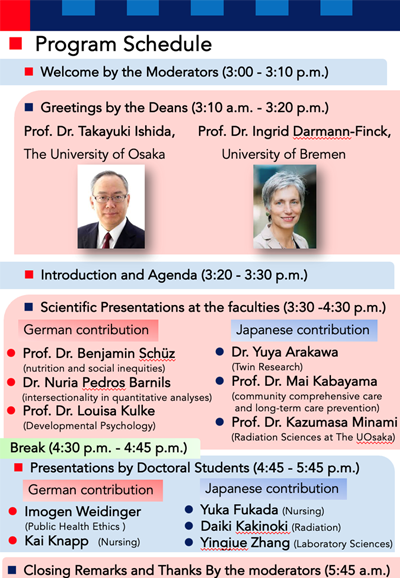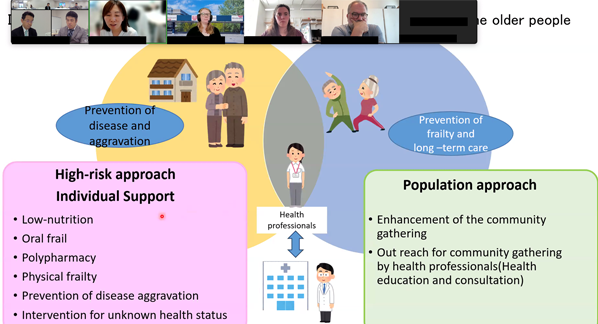News
International Activities
- From the International Exchange Center2025/11/04New
- From the International Exchange Center2025/10/24
Program for Fostering Home Care Professionals with an International Perspective
- From the International Exchange Center2025/10/22
Study Visit 2025, Mahidol University Ramathibodi School of Nursing
- From the International Exchange Center2025/10/08
Visit of Professor Hajo Zeeb, University of Bremen and Delegate of the Leibniz Association
- From the International Exchange Center2025/09/26
- From the International Exchange Center2025/09/05
- From the International Exchange Center2025/08/29
Associate Professor Minami presented at the Italy Pavilion Workshop, Expo 2025 Osaka–Kansai
- From the International Exchange Center2025/08/29
Summer Program 2025 (organized by Gerontological Nursing Lab)
- From the International Exchange Center2025/08/29
President Arto Maaninen from the University of Oulu, Finland, Visits the School of Health Sciences
- From the International Exchange Center2025/08/29
Commemorative Kick-off Event Held to Celebrate MOU with the University of Bremen
- From the International Exchange Center2025/07/22
- From the International Exchange Center2025/07/18
- From the International Exchange Center2025/07/11
The 32nd Global Seminar by Foreign Researcher at Takatsuki High school
- From the International Exchange Center2025/06/03
- From the International Exchange Center2025/05/28
Nursing Internship Program for The University of Hong Kong students
- From the International Exchange Center2025/05/21
Visit from Xinxiang Medical University to the School of Health Sciences
- From the International Exchange Center2025/05/21
Visit from Xinxiang Medical University to the School of Health Sciences
Click here for past international exchange activities
- 2024 school year
- 2023 school year
- 2022 school year
- 2021 school year
- 2020 school year
- 2019 school year
- 2018 school year
- 2017-2007 school year
2025
Study Visit 2025, Mahidol University Ramathibodi School of Nursing
October 1-3, 2025
One faculty member and eight graduate students from the Mahidol University Ramathibodi School of Nursing visited our division for a three-day training program. The program was designed to align with the students’ research interests and themes, and active participation along with lively Q&A sessions took place throughout each activity.
[Day 1]
- Home nursing study at a local clinic
- Exchange of opinions on the current status of AI in the nursing field in both Thailand and Japan
- Research presentations by the visiting graduate students
In the afternoon, Professor Miyae Yamakawa, specializing in geriatric nursing, delivered a lecture on Japan's healthcare system leveraging AI technologies. This was followed by a presentation on digital healthcare incorporating AI at Mahidol University, which led to a meaningful exchange of ideas. Each of the eight visiting master’s students also introduced their individual research projects, providing a valuable opportunity for discussion on conducting effective research.
[Day 2]
- Study of disaster medicine and disaster nursing
Although natural disasters occur less frequently in Thailand compared to Japan, a major earthquake struck an urban area in March this year, which has heightened interest in disaster nursing. At the Disaster Reduction and Human Renovation Institution, the participants deepened their understanding of the realities of disasters and preparedness measures. At the Hyogo Emergency Medical Center, they learned about the role of the center as a core disaster base hospital and were introduced to actual response cases, making it a highly valuable learning experience. The visit also provided an opportunity to compare and contrast the disaster medicine systems in Japan and Thailand, highlighting both differences and commonalities.
[Day 3]
- Community healthcare training
In Nose Town, the trainees visited the public health center and learned about oral care for the older adults through a picture-story show on “oral frailty” presented by a local dentist. They also joined local residents in Japan’s "Iki-Iki 100-Year-Life Exercise Program”, after which they sat in a circle and engaged in an open discussion on “secrets to living a healthy life.” These interactive activities provided the trainees with valuable insights through direct engagement with older adults in the community.
Many of the trainees are already practicing as nurses, and it is hoped that the knowledge and experiences gained through this training will be applied in their respective healthcare settings back home, contributing to the development of improved nursing systems.
Visit of Professor Hajo Zeeb, University of Bremen and Delegate of the Leibniz Association
October 3, 2025
Professor Hajo Zeeb from the University of Bremen, one of the partner universities with which the Division of Health Sciences at The University of Osaka has concluded a Memorandum of Understanding (MOU), visited our university as a member of the Leibniz Association delegation.
During his visit, Professor Zeeb also came to the Division of Health Sciences, where he met with Professor Kamide and Associate Professor Minami.
The University of Bremen is a comprehensive university located in the city of Bremen, the capital of the state of Bremen in northern Germany.
It consists of 12 faculties, covering a wide range of disciplines including natural sciences, engineering, social sciences, humanities, linguistics, and education. The university is highly regarded internationally, particularly in fields such as aerospace engineering, marine environmental sciences, and digital media.
Known as a research-oriented university, it actively engages in numerous externally funded research projects supported by organizations such as the German Research Foundation (DFG). Its interdisciplinary high-profile research areas promote innovative, cross-disciplinary collaboration.
In education, the University of Bremen emphasizes the principle of “research-based learning,” offering students opportunities to participate in research from an early stage. Many courses are project-based, fostering practical and independent learning.
The university is also recognized for its strong international orientation. It has established partnerships with institutions around the world and welcomes many international students, creating a multicultural learning environment that broadens students’ global perspectives.
During Professor Zeeb’s visit, discussions were held regarding future international exchange and collaboration between the University of Bremen and the School of Health Sciences. The meeting was highly productive, and we look forward to the continued development and strengthening of academic exchange between the two universities.
WEB symposium commemorating the Nursing Center for Ageing Well at the Ramathibodi School of Nursing, Mahidol University
‘Building Capacity for Integrated and Person-Centered Approach in Aging’
September 9, 2025
In commemoration of the establishment of the Nursing Center for Ageing Well at the Ramathibodi School of Nursing, Mahidol University, a web symposium titled “Building Capacity for Integrated and Person-Centered Approach in Aging” was held. The Division of Health Sciences,University of Osaka, which has an inter-departmental agreement with Mahidol University, co-hosted the symposium. Professor Kabayama, the MOU contact person, and Professor Kamide, a specialist in geriatric medicine, gave lectures on initiatives for preventive care for older adults in the community as well as management of elderly patients in hospitals, followed by various discussions.
The symposium attracted over 130 participants from around the world, fostering lively discussions. With the aging population advancing, particularly in Asia including Thailand, the event highlighted the strong interest among healthcare professionals and researchers in aging societies and geriatric care. We look forward to the further development of exchanges between our Division and the newly launched Center.
Program for Fostering Home Care Professionals with an International Perspective
September 7-13, 2025
From September 7 to 13, 2025, a program titled "Fostering Home Care Professionals with an International Perspective" was held in Hawaii. This educational program, supported by the Yuumi Memorial Foundation for Home Health Care, aims to cultivate home care professionals with a global outlook. It does so by comparing home care education and practice in Japan and the United States from a multidisciplinary perspective, allowing participants to learn about different approaches to home care, diverse treatment and support methods, and the roles and collaboration of various professionals.
From our university’s Division of Health Sciences, three graduate students participated, along with one each graduate student from the Divisions of Medicine and Dentistry, and one undergraduate student from the School of Pharmacy.
As part of the preparatory training, participants completed a one-day home medical care practicum and a two-day home nursing care practicum in August 2025. Prior to departure, a multidisciplinary workshop and a pre-departure presentation session were held. After returning, a debriefing session was conducted, with members of the Yuumi Memorial Foundation in attendance. A final report on the outcomes of the program is scheduled to be presented at a follow-up session in March 2026.
In Hawaii, we had the opportunity to visit dementia care facilities, medical care facilities for children, rehabilitation hospitals, and observe anatomy classes at the University of Hawaii. Additionally, we held sessions with nurse practitioners, hospice nurses, and home-visit nurses, which provided a valuable opportunity to reflect on and compare the healthcare systems of Japan and Hawaii.

Q&A session with a Hospice Nurse

Session with Hawaiian Home Health
Care Professionals on case studies
Personal Learnings
- I strongly felt in Hawaii that there is a cultural emphasis on the importance of the "individual" when it comes to expressing one’s wishes. For example, in Hawaii, people over the age of 65 are required to renew their POLST (Physician Orders for Life-Sustaining Treatment) annually. This reflects a society where talking about death is not a taboo, and where the importance of making one's wishes clear is well recognized.
- I realized that in Japan, there is a need to further strengthen both clinical practice and educational expertise in the healthcare field.
- I was surprised by the broad scope of practice granted to Nurse Practitioners (NPs) in the United States. In addition, the consultation time per patient is significantly longer, allowing for greater focus on the patient's life context, making the care feel more centered around "caring" than just treatment.
- I learned that in Hawaii, the evaluation of the quality of treatment and care is emphasized, and this focus on quality assessment contributes to maintaining a high standard of care.
- I was also surprised to see how much importance is placed on practical experience in professional education. For example, nursing students in Hawaii may be involved in advanced procedures such as inserting an arterial line during their training, and national licensing exams include clinical decision-making questions—these aspects highlight key differences from nursing education in Japan.
Special Lecture “Strategies of Digitalization into Clinical Practice”
by Professor Kristina Mikkonen, University of Oulu
September 1st, 2025
A special lecture by Professor Kristina Mikkonen from the Faculty of Health Sciences and the Faculty of Medicine, Health Sciences & Technology Research Unit, University of Oulu, titled “Strategies of Digitalization into Clinical Practice”, was held with many participants joining both in person and online. The lecture introduced cutting-edge international cases of digitalization in the medical and nursing fields, along with practical insights that can be immediately applied in our clinical settings. During the Q&A session, several graduate students raised questions, leading to a very lively and fruitful discussion.
Here is the lecture flyerOverseas study report: Summer program at Mahidol University, Thailand 2025
“Study Visit for Nursing Students”
August 18th – 29th, 2025
Four undergraduate students (two third-year and two second-year students) participated in a short-term training program hosted by the Ramathibodi School of Nursing, Mahidol University.
Although each student got aware of their own challenges in English communication, they were able to gain a wealth of knowledge and valuable experiences through daily lectures and facility visits. It was a highly meaningful and rewarding two-week program. Even after the program, the trainees have continued to stay in touch with the students from Mahidol University who supported them, and they have already shown strong motivation for the next opportunities in international exchange.
Reflections from each participant are provided below.
From the 3rd students:
During my training at Mahidol University, I experienced nursing education utilizing cutting-edge technology. In anatomy, displays and VR technology enabled three-dimensional visualization of human structures from muscles to nerves, providing me with learning opportunities unavailable in textbooks. Furthermore, through computer-based simulated patient care simulations, I experienced how practical critical thinking skills are cultivated. This environment enabled deep learning not only through knowledge input but also through output, proving highly stimulating.
Attending nursing classes in English for two weeks in Thailand was a significant opportunity for me to reassess my English skills. While I felt a great sense of accomplishment when I was able to understand both the specialized content and everyday communication, I also became keenly aware of what my English skills were missing and what I was not yet able to do. This experience made me realize how essential English proficiency is in order to work in an international setting in the future. Moving forward, I am determined to actively continue studying and improving my practical English skills.
From the 2nd students:
On the third day of the program, we gave presentations introducing our university, the city of Osaka, and the medical and nursing systems in place during disasters.
Since we rarely have the opportunity to present in English, this was a very valuable experience.
Next, during the cultural exchange session, we introduced the Japanese tradition of folding paper cranes (orizuru), and invited the trainees to try it themselves.
They showed great interest in the activity, and as we taught them how to fold the cranes, we were able to engage in a lot of natural communication.
My Thai buddy made time to see me not only on weekends but also on weekdays, taking me to delicious local restaurants and amazing sightseeing spots. We shared stories about ourselves in English, and my buddy kindly taught me about Thai healthcare and some Thai words. We really had an enjoyable time, and built such a close relationship that we shed tears for each other when it was time to say goodbye.
Associate Professor Minami presented at the Italy Pavilion Workshop, Expo 2025 Osaka–Kansai
July 17, 2025
On July 17, a workshop on future medical technologies was held at the Italy Pavilion of Expo 2025 Osaka–Kansai. As part of the program, a special session was dedicated to the emerging radiation therapy technology known as FLASH radiotherapy. Associate Professor Kazumasa Minami, faculty member in charge of promoting international exchange at the School of Allied Health Sciences, delivered a presentation.
FLASH radiotherapy is a novel technique in which an extremely high dose of radiation is delivered within an ultra-short time frame (from milliseconds to seconds).
Compared to conventional irradiation methods, it maintains the tumor regression effect while drastically reducing damage to normal tissues—a phenomenon known as the
FLASH effect. This approach has been drawing significant attention worldwide.
Associate Professor Minami’s group was the first in the world to observe the FLASH effect using human cells, and their pioneering work has garnered global recognition. With this technology, a single daily radiation treatment could be completed in just 0.02 seconds. This remarkable reduction in treatment time is expected to improve patients’ quality of life (QOL) and realize less burdensome cancer therapies.
The presentation was also broadcast on a large screen in front of the Italy Pavilion as well as by Italian television stations, bringing the concept of future radiation therapy to a wide general audience.
Summer Program 2025 (organized by Gerontological Nursing Lab)
30th June – 11th July, 2025
The two-week summer program, jointly organized by our Gerontological Nursing Lab and the GURUME KINEYA Social Contribution of the G.K. Social Welfare Foundation, was held again this year. A total of 12 trainees from four universities in Taiwan and China participated. The program offered a variety of activities, including lectures by internal and external experts, workshops, and visits to companies and care facilities, all centered around the theme of long-term care in Japan’s super aging society.
Approximately 30 students from the Lab also supported the program each day as assistants to the trainees. By accompanying them to lecture venues and care facilities and serving as interpreters, they not only improved their English skills but also gained valuable insights into caregiving systems and challenges in various Asian countries. Additionally, the valuable feedback they received from the trainees during presentations on their own research became a significant source of motivation for their future academic work.
CLICK HERE for the program scheduleComments from exchange students:

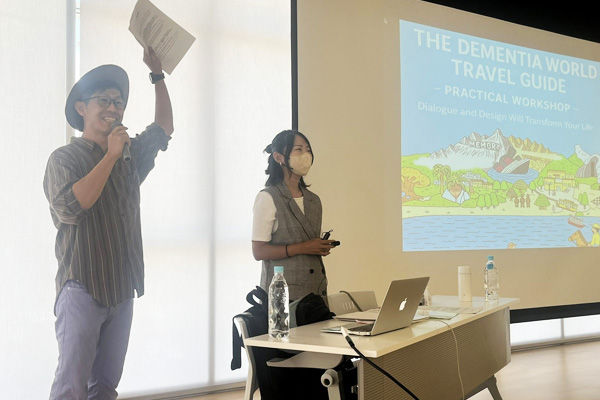
In the lecture on the Dementia World Travel Guide, we gained valuable insights into various aspects of dementia. In the following workshop, we used cards to explore common symptoms of dementia—such as memory loss, confusion, and disorientation in time and place—deepening our understanding while discussing practical care approaches in groups. Through this interactive card game, we became more aware of the importance of empathy and effective communication. I strongly hope to bring this approach back to Taiwan, so that more people can learn about dementia from the perspective of those living with it, in an accessible and relatable way.
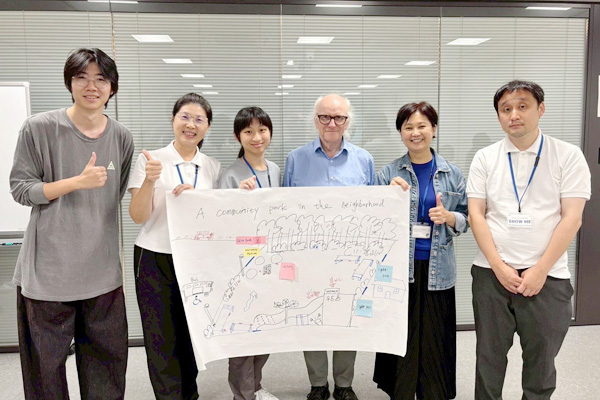
The workshop "Enhance an Optimal Environments in Super-Ageing Society" offered a completely new perspective on designing better environments in caregiving settings. I was especially impressed by the idea that environmental design should be tailored to accommodate neurodiversity. The concept ‘creating spaces that support social connections helps us feel more connected and less lonely’ was also deeply thought-provoking.
The professor’s proposed cycle of "Sensory – Prediction – Action" resonated strongly with the concept of adapting aging-in-place in elderly care, and it offers a valuable framework for supporting a high quality of life in later years.
Through group brainstorming sessions, I was able to recognize the potential synergy between design and nursing.
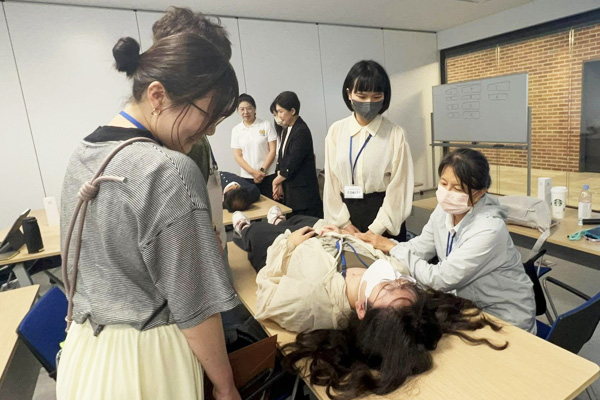
The online lecture on End-of-Life Care by a Japanese pastor living in the United States was an incredibly valuable learning experience. I was deeply moved by the Japanese end-of-life rituals, such as offering the final sips of water and angel care, and I strongly wish to incorporate this spirit into end-of-life care at my workplace.
The “six words to speak to the dying” and the three types of healing techniques also left a profound impact on me. Beyond medical support, I learned that a well-structured end-of-life care system not only upholds the dignity of the patient, but also provides guidance and comfort to ensure that families do not miss the opportunity to be present for their loved one’s final journey.
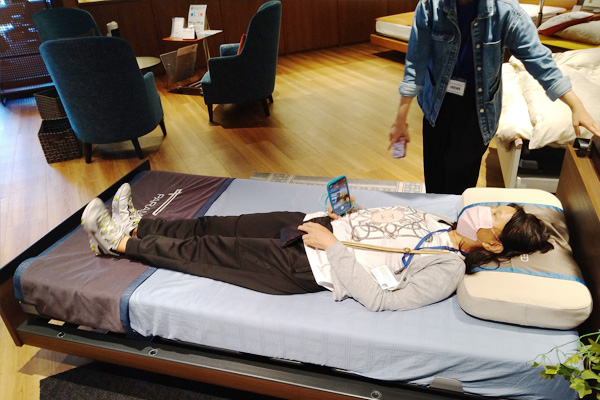
Our visit to Paramount Bed Co., Ltd. provided valuable insights into the company’s innovative designs for pillows, as well as medical and nursing care beds. Their advanced features—such as motorized height and angle adjustments, side rail systems, pressure sensors, and sleep monitoring—enhance not only patient comfort and safety but also help reduce the physical burden on caregivers.
Among these, the smart toilet sensor was particularly impressive. By detecting the color and condition of urine and feces, it contributes to monitoring excretion patterns and overall health conditions. These beds, which are both highly functional and aesthetically designed, serve as an important point of reference for the future development of caregiving and welfare technologies in Taiwan.
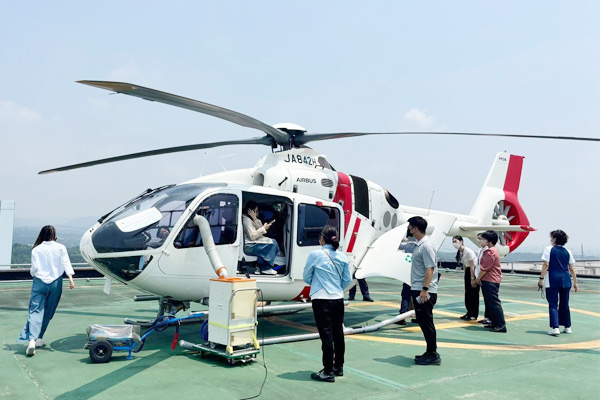
The visit to the newly opened ward of The University of Osaka Hospital, which opened this May, was an exceptional and invaluable opportunity. The new ward is spacious and filled with natural light, and it incorporates state-of-the-art medical technologies. The ICU is located adjacent to the day surgery ward, and the isolation rooms are equipped with remote monitoring capabilities. Corridors connecting the different wards help reduce walking distances, and the pediatric ICU is equipped with a dedicated emergency transport route. These design elements clearly reflect a commitment to both nursing efficiency and patient-centered care.
It was also striking to observe the relatively high number of male nurses in the Advanced Emergency and Critical Care Center, indicating progress in gender diversity. Physicians and nurses work together in a shared open space, breaking down hierarchical barriers and enabling smooth communication and effective teamwork—quite different from the more compartmentalized work environments often seen in Taiwan.
One of the most memorable parts of the visit was observing the medical rescue system involving the Doctor-Heli. In Japan, becoming a flight nurse requires over five years of clinical experience (including at least three years in acute care), completion of specialized training, and passing a certification exam. Flight nurses must always be on standby and are required to reach the helipad within five minutes of being called. They may perform advanced procedures such as CPR while in flight.
Being able to witness such an advanced, efficient, and patient-centered healthcare system firsthand was an incredibly meaningful experience. It also gave me the opportunity to reflect on Taiwan's own medical infrastructure and provided many insights for potential improvements. This truly was a valuable and eye-opening experience.
Comments from UOsaka assistants:
Learning about the similarities and differences across countries and cultures was a valuable opportunity that brought many new insights. What I found particularly interesting was that, although there is a common tendency in many Asian countries to avoid discussions about death, the approaches and systems in place to address this vary significantly between countries. These differences provided important insights into the challenges and strategies involved in promoting Advance Care Planning (ACP).
Since there were fewer trainees than in previous years, we had more opportunities for communication between the trainees and UOsaka students through group work and other activities. Although I was not confident in my English and was worried about whether I could communicate effectively, through repeated interruption and interactions in the workshops, my fear of speaking English gradually faded. I realized once again that rather than focusing solely on "speaking English well," having the willingness to actively engage in communication is what truly matters when building relationships. This experience also motivated me to further improve my English skills.
Having the opportunity to explain my research in English helped me articulate the core essence of my work more clearly. In addition, interacting with other researchers in the same field was highly meaningful, as I was able to gain various opinions and perspectives on my research topic.
I was happy that the Chinese I had been studying on my own proved useful outside of the Program and was appreciated by the trainees. I realized that speaking someone's native language conveys respect and genuine interest in their culture. These two weeks allowed me to feel my own growth in terms of language skills. Looking ahead to next year's program, I hope to further brush up on my abilities.
Participation in the health conference “Living Longer, Living Well: Innovations for Healthy Ageing” at the Czech Pavilion, Expo 2025 Osaka, Kansai, Japan
June 24, 2025
On June 24, 2025, a health conference entitled “Living Longer, Living Well: Innovations for Healthy Ageing” was held at the Czech Pavilion during Expo 2025 Osaka, Kansai, Japan. Professor Kabayama from the division of Health Sciences at our university was invited as a speaker, and six graduate students, five faculty members, and three staff members participated at the venue as special invited guests.
This conference was co-hosted by the Czechia government and Masaryk University, and aimed to discuss advanced research and practice for the realization of Healthy Ageing.
The conference began with a keynote speech by Professor Jakub Hlávka of Masaryk University entitled "Living Longer, Living Well: Innovations for Healthy Ageing." He explained the difference in life expectancy between the Czechia and Japan, comparing various background factors. Next, Professor Mai Kabayama of the University of Osaka, Professor Maho Haseda of Kyoto University, and Professor Emi Rosenberg of the WHO Kobe Center introduced research and practice on Healthy Ageing from the perspective of their respective fields of expertise.
Professor Kabayama introduced the current situation of rapid population aging in Japan, including ongoing research in Nose Town, Osaka Prefecture. She emphasized that achieving healthy ageing requires not only improvements in medical and nursing care, but also the promotion of social connectedness.
In the panel discussion session, a lively debate took place from the perspectives of industry, government, and academia. One particularly striking comment came from a member of the audience — a local government administrative staff member from Nose Town. Referring to the current state of nursing care in mountainous areas, he expressed his strong determination by stating, “In order to achieve healthy longevity, it is important for local governments to seriously face the realities on the ground and build a sustainable support system.” Ms. Yuka Fukada, a graduate student of the University of Osaka, also explained that Healthy Ageing includes improving dignity and quality of life (QOL) in the final stages of life, as well as encompassing the concept of end-of-life care. In addition, a member of the audience expressed the view that “intervention is necessary not only after one becomes elderly, but also starting from the younger generation,” emphasizing the importance of a life course approach. Professor Yasuyuki Gondo, a centenarian research expert of the University of Osaka, posed a fundamental question: “Given that there are biological limits to human lifespan, to what extent should we researchers aim for Healthy Ageing?” This sparked a very heated discussion. Ms. Shio Sugita, division manager of the Community-based Integrated Care Promotion Division at the Kinki Regional Bureau of Health and Welfare, introduced best practices in community-building in the context of an aging society from the Kansai region. These fascinating and advanced initiatives were shared with researchers from the Czechia. Hankyu Hanshin Holdings introduced various intervention cases aimed at reaching a broader audience. It was impressive to see the company’s flexible approach to promoting Healthy Ageing by continuously organizing a wide variety of events that local residents can enjoy participating in, which encourages behavioral changes in people.
The event was conducted in a very warm and welcoming atmosphere from start to finish. During breaks and between sessions, participants were often seen chatting naturally with one another, discussing each other’s research and sharing their awareness of various issues.
This conference provided a valuable opportunity for every participant—regardless of country, region, occupation, or field of expertise—to reflect on and consider together the question: “What is Healthy Ageing?” We would like to express our sincere gratitude to the organizers and all participants for making this meaningful event possible.
Belgium Pavilion Event at the Osaka-Kansai EXPO
June 19, 2025
I had the honor of participating as a panelist in the event "Global Health, Local Strengths: Connecting Centers of Excellence in R&D and Pharma Logistics" held at the Belgium Pavilion of the Osaka-Kansai EXPO. This event was organized by the University of Antwerp in Belgium, which has conducted over 20 years of international collaborative research on WT1 immunotherapy with Professor Emeritus Haruo Sugiyama. Through Professor Sugiyama's involvement, our Department of Health Sciences was given the opportunity to participate.
I took part in a panel discussion titled "Innovation Health R&D Synergies: Antwerp Meets Japan," moderated by Professor Patric De Boever, Director of Research at the University Hospital Antwerp. As one of the five panelists, I introduced The University of Osaka Faculty of Medicine, discussed the university research of ecosystem, and expressed our expectations for future collaborations with the University of Antwerp. The session led to a fruitful exchange of ideas on future cooperation.
This event marked a valuable step forward, and we sincerely hope that it will lead to significant development in the collaboration between The University of Osaka Department of Health Sciences and the University of Antwerp’s Faculty of Medicine.
The 32nd Global Seminar by Foreign Researcher at Takatsuki High school
17 June 2025
My name is Alice Young. I hold a bachelor’s degree in Psychology and am currently a Fulbright Fellow researching in Professor Kamide’s laboratory. As I start this report, I would like to offer a heartfelt thank you to Takatsuki highschool for inviting me to participate in such a wonderful event emphasizing global cultural sharing, and an additional thank you to Dr. Kamide for suggesting I participate.
On 17 June 2025, I was honored to be invited as a lecturer at Takatsuki High School. The purpose of my visit was to share my experiences in researching in Japan, as well as offer a brief look into the Emergency medical system in America. My research focus in Japan has been on Advanced Directives, which are documents used to specify care required for patients in the future, and often regard end-of-life decisions for patients. As such, my research can be a very difficult topic to discuss, but I was pleased to find all of the students very receptive to participating in my talk. Accompanied by Professor Kobayashi, I arrived at around 10:30 a.m. and received a brief introduction about the history of the school from Mr. Kudo, Principal of Takatsuki High School.
After a brief conversation, we proceeded to the meeting room where students from different grades were eagerly waiting. I presented to the students about the aforementioned topics, before holding a very enjoyable question and answer session with the students. My presentation lasted for around 30 minutes, and the students questions almost all pertained to my research. The students were very curious about advanced directives, and I took great joy in seeing so many youth passionate about care for the elderly. These students asked questions such as, “Why do you think older people don’t want to use advanced directives,” and, “Why do more Americans know about advanced directives than Japanese people?” Additionally, the students were curious about language learning, and I was blown away by their confident command of English.
I was very pleased to then be offered a tour of the school by Mr.Yokoyama, who showed me the classrooms, as well as the global learning center. In the center, I was thrilled to see that students have the opportunity to visit both the United States and the United Kingdom, as well as to see many tokens from former foreign visitors. Lastly, we visited the library, which was absolutely beautiful, and allowed me to observe students working hard in class.
Overall, the visit was incredible, and I am very touched to have been included in such an important event. I hope that the students continue to work hard in the future, and I hope to continue to be a network for students in Japan seeking a more global perspective.
President Arto Maaninen from the University of Oulu, Finland, Visits the School of Health Sciences
June 5
On Thursday, June 5, 2025, President Arto Maaninen from the University of Oulu, Finland—an institution with which we have a Memorandum of Understanding (MOU)—visited the School of Health Sciences.
The University of Oulu, located in the northern Finnish city of Oulu, is a national university established in 1958. With approximately 13,500 students, it is one of Finland’s leading comprehensive research universities. The university boasts a top-tier research standard within Finland and enjoys high international acclaim, consistently ranking among the top universities in the QS World University Rankings.
The University of Oulu excels in a wide range of fields, including information and communication technology (ICT), medicine and life sciences, environmental science, engineering, and education. Notably, its globally recognized research in wireless communications (5G/6G), developed through collaboration with Nokia, places it at the forefront of next-generation telecommunications via the 6G Flagship program.
In the field of medicine, the university maintains a strong educational and research system in close collaboration with the affiliated Oulu University Hospital (OYS), focusing on areas such as genomic medicine, biobank research, and digital health. Furthermore, leveraging its geographical proximity to the Arctic, the university actively conducts environmental research on climate change and northern ecosystems.
During this visit, active discussions were held on the achievements of past joint research between the School of Health Sciences and the University of Oulu, as well as on frameworks for further international collaboration in the future.
Commemorative Kick-off Event Held to Celebrate MOU with the University of Bremen
June 4, 2025
In October 2024, the School of Health Sciences at the University of Osaka signed an interdepartmental academic exchange agreement (MOU) with the Faculty of Human and Health Sciences at the University of Bremen, Germany. The Faculty of Human and Health Sciences at Bremen is known for its interdisciplinary approach to exploring human health and well-being, spanning a wide range of fields including epidemiology, public health, nursing, sports science, and psychology. Its strong ties to community engagement, policy, and clinical practice, along with advanced research networks such as those with the Leibniz Institutes, make it a highly dynamic partner in education and research.
To commemorate the signing of this agreement, an online symposium titled "Commemorative Kick-off Event for the Conclusion of the MOU" was held on June 4, 2025. The event featured research introductions by faculty members from both the University of Osaka and the University of Bremen, as well as presentations by graduate students.
The symposium sparked lively discussion and laid the foundation for future collaboration.
Through this new partnership, we look forward to further enhancing research cooperation and student exchange between our two institutions.Participation in the Exhibition and Experience Booth for the Seal-Type Mental Commitment Robot “PARO” at EXPO 2025 Osaka, Kansai, Japan
May 4th – 10th, 2025
From May 4th to 10th, 2025, a total of approximately 50 participants—including undergraduate and graduate students, as well as faculty members from the School of Health Sciences, The University of Osaka —volunteered at the exhibition and experience booth for the seal-type mental commitment robot “PARO,” presented by Dr. Shibata of the National Institute of Advanced Industrial Science and Technology. This booth was part of the exhibit entitled “Future Field Clinics: Zero-Emission Disaster Medicine”, organized by the Disaster Nursing Research Institute of the Japanese Red Cross College of Nursing, and held at the Gallery WEST of EXPO 2025 Osaka, Kansai.
In Japan, “PARO” has been selected as a designated device under the Ministry of Health, Labor and Welfare’s priority initiative in care technology, particularly in the area of “support for daily life and care of individuals with dementia.” It is utilized in dementia care and has been recognized for its effectiveness in alleviating symptoms of both “dementia” and “delirium”. Internationally, including in the United States, Europe, and Asia—where healthcare and welfare systems differ—PARO is classified as a medical device supported by evidence for its non-pharmacological therapeutic benefits. It is used in over 50 countries worldwide, including in the treatment and care of PTSD among military veterans and for mental health support in pediatric intensive care settings.
The volunteer staff received direct instruction from Dr. Shibata, the developer of PARO, and assisted visitors by providing explanations and facilitating hands-on experiences with the robot. The booth attracted a wide range of visitors of various age groups, from children to the elderly, both from Japan and abroad. Many visitors held PARO, gently stroked its back, and engaged with it, expressing delight and keen interest, and were naturally warm smiling. Moreover, the volunteers themselves found the experience deeply comforting and fulfilling, making their participation in the EXPO a meaningful and memorable occasion filled with positive interactions and smiles.
-
EXPO visitors experiencing the “PARO” experience.
(All photos courtesy of National Institute of Advanced Industrial Science and Technology.)
Nursing Internship Program for The University of Hong Kong students
April 21st – May 16th, 2025
Four third-year nursing students from the University of Hong Kong (UHK) participated in a three-week internship program at our university from April 21 (Mon) to May 16 (Fri), 2025. The UHK and our department signed an MOU in 2018, and since then, many faculty members, undergraduate and graduate students from UOsaka have participated in events such as the Hong Kong International Nursing Forum and Inbound students exchange programs organized by the UHK, continuing academic exchange.
The internship program was led by faculty members and graduate students from all areas of Integrated Health Nursing Science. A three-week program was designed to allow participants to learn about the characteristics of each area. On the final day, a session was held to share insights gained during the internship. All trainees’ presentations were excellent, comparing what was learned about Japanese healthcare, nursing, and public health services with examples from Hong Kong.
A seminar on maternal and child health was held with our graduate students. They gave presentations on “Japan's Perinatal Healthcare & Women's Health System” and “Perinatal Mental Health in Japan.”
- The trainees participated in lectures and seminars for the graduate public health nurse course and interacted with our graduate students.
- They visited the home of an ALS patient and observed home rehabilitation services. They learned about the life of a patient undergoing treatment at home while on a ventilator, and about a method of communicating with the patient by reading her mouth movements.
- Accompanied a professor on a home visit to patients receiving home care and on a resident of a paid nursing home for care
- Students visited the Disaster Reduction and Human Renovation Institution to learn about real-life disaster situations, and then actively engaged in discussions on disaster prevention, risk reduction, and nursing during disasters.
- Students joined a local gathering of older people and did exercises together, gaining insight into efforts for frailty prevention and the daily lives of them. It was a wonderful opportunity to experience Japan’s beautiful rural landscape as well!
A group photo taken at the end of the Universal Design workshop with wheelchair users. It captures the sense of accomplishment after three hours of discussion.
Participants are listening attentively as wheelchair users share their personal experiences of the challenges they've faced in daily life. The speaker is a graduate of our university.
A scene from the group presentations during the Universal Design workshop held in collaboration with wheelchair users.
The trainees gave excellent presentations on the topics of interest to each individual, reflecting what they learned through this Program.
Mini-Workshop on USM-UOsaka Research Collaboration
On April 11, 2025, a workshop on research collaboration between Universiti Sains Malaysia (USM) and The University of Osaka was held on the 3rd floor of Centerace at the Suita Campus. Currently, the School of Health Sciences offers the "Frontiers in Radiation Therapy and Medical Imaging Technology" program for graduate and undergraduate students from ASEAN countries as part of the Osaka University International Certificate Program (OUICP). At the workshop, Associate Professor Kazumasa Minami, who is in charge of promoting international exchange at the School of Health Sciences, introduced the department's international initiatives and detailed the offered programs. The event was attended by four representatives from USM, including the President and Vice President, and twelve participants from Osaka University. The workshop featured lively discussions and active exchange of ideas.
Visit from Xinxiang Medical University to the School of Health Sciences
On April 7, 2025, a delegation of five members from Xinxiang Medical University in China, including the university president and the director of its affiliated hospital, visited the School of Health Sciences. Xinxiang Medical University ranks among the top 30 universities in China. It began as a nursing school and has since expanded to include five affiliated hospitals and twenty associated hospitals. The university is highly regarded as a medical research institution, both in terms of hospital and academic evaluations.
As this was their first visit, Professor Ishida, Dean of the School of Health Sciences, and the International Exchange Center provided an introduction to Osaka University. Xinxiang Medical University was also introduced, and both sides engaged in a lively exchange of ideas about potential future collaborations between the two universities.


























